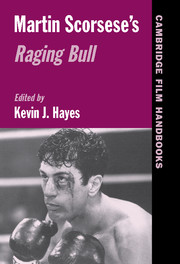Book contents
- Frontmatter
- Contents
- List of Illustrations
- List of Contributors
- Abbreviations
- Introduction: The Heritage and Legacy of Raging Bull
- 1 Art and Genre in Raging Bull
- 2 Visual Absurdity in Raging Bull
- 3 Raging Bull and the Idea of Performance
- 4 Women in Raging Bull: Scorsese's Use of Determinist, Objective, and Subjective Techniques
- 5 My Victims, My Melancholia: Raging Bull and Vincente Minnelli's The Bad and the Beautiful
- REVIEWS OF RAGING BULL
- Filmography
- Select Bibliography
- Index
5 - My Victims, My Melancholia: Raging Bull and Vincente Minnelli's The Bad and the Beautiful
Published online by Cambridge University Press: 24 November 2009
- Frontmatter
- Contents
- List of Illustrations
- List of Contributors
- Abbreviations
- Introduction: The Heritage and Legacy of Raging Bull
- 1 Art and Genre in Raging Bull
- 2 Visual Absurdity in Raging Bull
- 3 Raging Bull and the Idea of Performance
- 4 Women in Raging Bull: Scorsese's Use of Determinist, Objective, and Subjective Techniques
- 5 My Victims, My Melancholia: Raging Bull and Vincente Minnelli's The Bad and the Beautiful
- REVIEWS OF RAGING BULL
- Filmography
- Select Bibliography
- Index
Summary
Despite the many transtextual moments in Raging Bull, its engagement with Vincente Minnelli's The Bad and the Beautiful (1952) has largely escaped critical attention. When Scorsese put together his meditation on American cinema, A Personal Journey with Martin Scorsese Through American Movies (1995), he chose to begin the four-hour documentary with a clip from Minnelli's film about a megalomaniac Hollywood producer and three victims of his boundless ego. Many years before this, in New York, New York (1977), Scorsese shot a violent car scene in homage to one of the emotional high-points of The Bad and the Beautiful. In Raging Bull itself, allusions to Lana Turner in The Postman Always Rings Twice (1946), Kirk Douglas in The Champion (1949), and Minnelli as director of The Father of the Bride (1950) inevitably lead us to consider The Bad and the Beautiful – the tale of angst-ridden Hollywood masculinity in which the three stars combine forces. Furthermore, in those key moments of desire in Raging Bull, when Vickie dangles her legs in the pool and later over the foot of the bed, Scorsese makes reference to the first thing we see of Lana Turner in The Bad and the Beautiful when her legs (also her entrée in The Postman Always Rings Twice) hang down from a hole in the roof of an abandoned Hollywood mansion.
- Type
- Chapter
- Information
- Martin Scorsese's Raging Bull , pp. 116 - 134Publisher: Cambridge University PressPrint publication year: 2005

